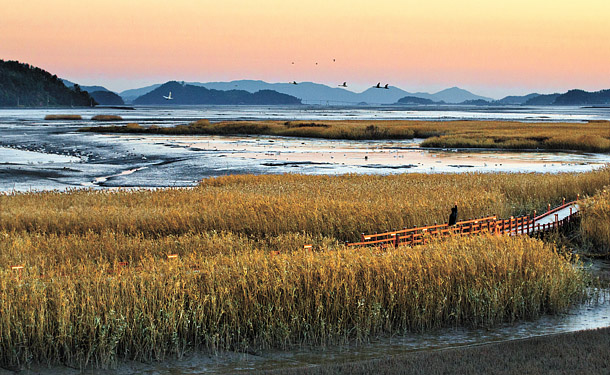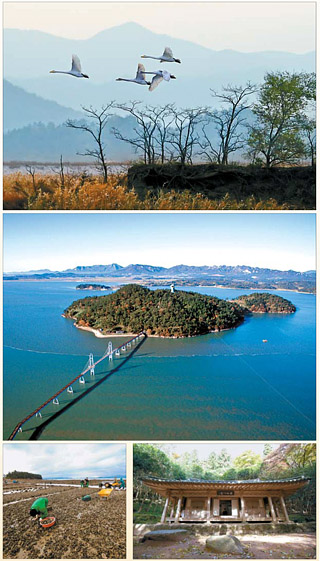Greeting the early winter’s beauty in Gangjin : Visitors to the once-isolated area find ideal natural surroundings

The reed beds of Gangjin are a popular destination for visitors who travel to the coastal county. Whooper swans welcome visitors this time of year. [LIM HYUN-DONG]
Elsewhere, the county’s famous oysters are freshly harvested by the locals of Gauh Island, while the Camellia flowers have started to blossom into a crimson red sooner than expected at the Buddhist temple of Baekryeon. In the midst of the dropping temperatures, the county makes for an adventurous journey as it provides the ideal scenery to experience the seasonal transition.
The county of Gangjin is shaped like an upside-down V. Between the “legs” of the coastal area is where the sea is easily accessed and depended upon by locals. Fishing boats sailing along the sea are a common sight, as are the oysters that live in the muddy coastal wetlands. These mud flats have become something of a natural wonder in Korea.
But the real draw is the incredibly large reed beds. These reeds are spread across the county, occupying a space of 66,000 square meters (16.3 acres). In terms of sheer size, the reed beds of Suncheon city may be the most famous, but the mood and atmosphere of the reeds in Gangjin are incomparable. They were even chronicled in the famous novel “Han River” by author Jo Jung-rae.

Top: Large whooper swans are frequent guests above the reed beds. Middle: Gauh Island can be accessed by two bridges that connect it to Gangjin. Bottom Left: County locals begin their oyster harvest. Bottom Right: The historical home of Dasan, the Dasan Chodang [LIM HYUN-DONG]
The harbor that the novel was referring to is now called Nampo Village as the harbor itself is long gone. This is a result of land reclamation efforts from the era of Japanese colonization. However, the reeds have consistently stood in place to watch over the wetlands. Some argue that the reed beds are most picturesque in March as they sway in the winds while flaunting their natural colors. However, it doesn’t take away from the golden colors that the reeds take on during the early winter season.
The whooper swans, which are designated as Natural Monument No. 201, also make Gangjin their natural habitat. A rare sight in which the fluffy seeds from the reed flowers are carried by the local birds to be scattered across the wetlands is an occurrence that can only be seen from late November to early December.
The reed beds stretch from the mouth of the Tamjin River all the way into the mud lands of Nampo Village. Until recently, the reed beds could only ever be seen from far away. However, thanks to the construction of a walkway, it has became possible to walk through the tall reeds. In the mud flats themselves, gobies and sand crabs that have yet to receive the news of the coming winter are still seen fiddling about in the mud, while whooper swans and mallards swim and fly about in the water.
Signs of the coming winter can be further seen from the Camellia Forest of Baekryeon Temple, located on Mount Mandeok. While the Camellia’s ordinarily start blossoming during the winter and peak during the spring, the flowers have already begun to bloom, earlier than expected. Across from the forest is where the Osol Trail lies, which is carpeted with fallen leaves in the fall foliage colors.
Walking upwards of one kilometer (0.62 miles) on the trail will bring travelers to the Dasan Chodang, which is the house where the philosopher Jeong Yak-yong (1762-1836), also referred to as Dasan, lived during his 18-year exile. Though the philosopher was recorded as having lived in many places in Gangjin, he spent most of his time at the Chodang. Between 1808 and 1818, when the Chodang was occupied, Dasan wrote some of his greatest works, including “Mind of Governing the People,” “Design for Good Government,” and 500 other works of literature.
Even this late into November, the Dasang Chodang has yet to see any signs of winter as the autumn trees near the house are drenched in bright autumn colors. From below the mountain, visitors will be able to see the setting sun cast its glowing lights on the reed beds across Gangjin.
When travelling by car, Gangjin County doesn’t provide any shortcuts to travel between its peninsulas. Whether travelling to the southern side of Gangjin or the northern side, trying to visit the opposite area requires driving all around the county. Luckily, the view of the sea from the car while driving on the highway is certainly not boring, as it is unlike driving on any other highway.
On the other hand, while travelling on foot, there is a very simple shortcut that connects from either side to Gauh Island that rests in the middle of the water between the legs of lands. Often referred to as the Gauh Island Rope Bridges, two bridges extend from wither side of the island, one is 438 meters (1437 feet), while the other goes on for 716 meters.
Though Gauh Island is only one of eight islands within Gangjin that is inhabitable by people, its population has remained low. The residents of the island and the locals of Gangjin have led mostly independent lives. That was until the bridges were built in 2011. The sights of the island mostly remained a secret until the construction of the bridges revealed their beauty to the outside world. Just last year, approximately 400,000 visitors visited the island, while the actual number of residents only totals 40 people living in 15 households.
Walking across the rope bridges above the water makes for an exciting experience in itself, and despite common misconceptions, the bridges are incredibly stable. When arriving on the island, visitors will be met by the entrance of the “Hamkkehae Gil” which translates to “Let’s do it together road.” The path circles around the island for 2.5 kilometers, which makes for a light and easy walk. On the hike, visitors will come across a small forest inhabited by amber and pine trees.
The island itself is on the smaller side at 0.32 square kilometers. There are, however, a variety of enjoyable activities to do for visitors. These activities include being able to fish at the Haesang Fishing Park, and also taking a visit to the restaurants operated by island locals. What was previously a warehouse was remodeled to offer speciality seafood dishes, as well as desserts including coffee and ice cream.
Rather than walking back out the same way, there is actually a much faster way to exit the island. By taking the zip line from the Celadon Tower located in the middle of the island, visitors can fly out of the island on a short one minute journey, which makes for an exciting conclusion to the trip.
Fans of seafood are in for a pleasant surprise as delicacies such as seaweed, spoon worms, and small octopus are caught even during the cold winter. However, locals and visitors alike agree that when this particular season arrives, what is on everybody’s minds are none other than Gangjin’s famous oysters. As a local woman named Jang Gyeong-ae, 83, put it, “The taste of the oysters is fresh. It means winter has arrived.”
The travel time from Seoul to Gangjin County takes approximately 4 hours and 30 minutes by car. The whooper swans and mallards can ordinarily be seen in the county until February, while the zip line on Gauh Island can be accessed between 9 a.m. and 6 p.m. Entrance costs 25,000 won ($21).
The restaurants of Gangjin are also famous for their long history and reputation, particularly the “Haetae Restaurant,” which opened in 1981 and is famous for its traditional Korean dishes. Though these dishes differ every season, fresh oysters, raw octopus, yukhoe (raw ground beef) and a total of 28 sides are served during the winter. The meal costs 60,000 won for two people. Call 061-434-8288 for more information.
Elsewhere, the Gangjin County provides opportunities to experience first-hand traditional Korean culture. One such location is the Sauijae, which is a re-creation of traditional Korean homes. A one night stay starts from 40,000 won. Call 061-430-3312 for more information.
BY BAEK JONG-HYUN [chung.jinhong@joongang.co.kr]










with the Korea JoongAng Daily
To write comments, please log in to one of the accounts.
Standards Board Policy (0/250자)